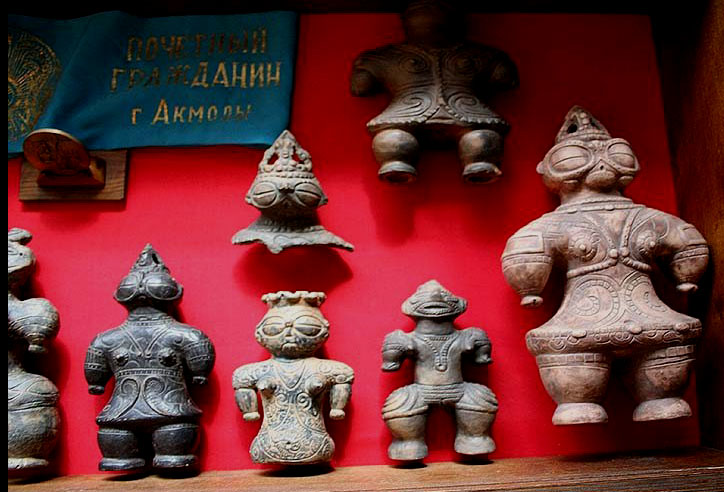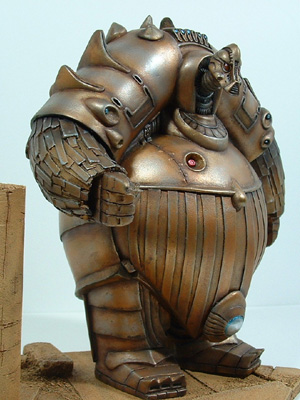It looks like you're using an Ad Blocker.
Please white-list or disable AboveTopSecret.com in your ad-blocking tool.
Thank you.
Some features of ATS will be disabled while you continue to use an ad-blocker.
share:
BTW, another part of the Mahabharata which shows these weapons, and technology was given to the Hindu by the "celestials", and references to
"celestial weapons" can be found in many chapters.
For example...
www.sacred-texts.com...
The weapons, and technology were called CELESTIAL for a reason, and not because they were invented by the Greeks as you claim....
Oh and btw, Vrihaspati should be written "Brihaspati" who was the "revered preceptor of Indra" both Brihaspati and Indra are Hindu gods who as you can see were some of the gods who gave this technology to the Hindus, despite your lies, I mean claims...
For example...
...
"Vaisampayana continued, 'Hearing these words of Arjuna, Angaraparna became inflamed with wrath and drawing his bow to a circle began to shoot his arrows like venomous snakes at the Pandavas. Then Dhananjaya, the son of Pandu, wielding a good shield and the torch he held in his hand, warded off all those arrows and addressing the Gandharva again said, 'O Gandharva, seek not to terrify those that are skilled in weapons, for weapons hurled at them vanish like froth. I think, O Gandharva, that ye are superior (in prowess) to men; therefore shall I fight with thee, using celestial weapons and not with any crooked means. This fiery weapon (that I shall hurl at thee), Vrihaspati the revered preceptor of Indra, gave unto Bharadwaja, from whom it was obtained by Agnivesya, and from Agnivesya by my preceptor, that foremost of Brahmanas, Drona, who gave it away to me.'
...
www.sacred-texts.com...
The weapons, and technology were called CELESTIAL for a reason, and not because they were invented by the Greeks as you claim....
Oh and btw, Vrihaspati should be written "Brihaspati" who was the "revered preceptor of Indra" both Brihaspati and Indra are Hindu gods who as you can see were some of the gods who gave this technology to the Hindus, despite your lies, I mean claims...
edit on 14-1-2014 by ElectricUniverse because: (no reason given)
BTW, I have noticed that for some strange reason that website "sacred-texts" has edited the word Vimana completely from all their translations.
For example, in Sanskrit, it is known that Rama's vehicle is called "Pushpaka Vimana", yet at "sacred-texts" they just mention it as "Pushpaka".
Even Wikipedia recognizes this fact.
en.wikipedia.org...
Let me give an example.
www.sacred-texts.com...
In fact, the word Vimana is completely absent in all the translations from the "sacret-texts" website for whatever reason, which is strange.
If you search on Indian sources, they all refer to it as "Pushpaka Vimana".
For example.
bharathgyanblog.wordpress.com...
www.dnaindia.com...
It is strange that in ANY Indian/Hindu website and even scholars describe it as Pushpaka Vimana, but the website "sacret-texts" has it only as Pushpaka.
I also mentioned another mistake they at "sacred-texts" made when they mention "Vrihaspati" instead of "Brihaspati".
For example, in Sanskrit, it is known that Rama's vehicle is called "Pushpaka Vimana", yet at "sacred-texts" they just mention it as "Pushpaka".
Even Wikipedia recognizes this fact.
Pushpaka
From Wikipedia, the free encyclopedia
Jump to: navigation, search
Pushpaka may refer to:
Pushpaka Vimana, a flying chariot mentioned in the Hindu epic Ramayana
...
en.wikipedia.org...
Let me give an example.
...
p. 568
also asked for the restoration to life of all those monkeys that had been slain by the Rakshasas, and after Brahma had said--So be it, those monkeys, O king, restored to life, rose up from the field of battle, and Sita too, of great good fortune, granted unto Hanuman a boon, saying, 'Let thy life, O son, last as long as (the fame of) Rama's achievements! And, O Hanuman of yellow eyes, let celestial viands and drinks be ever available to thee through my grace!'
"Then the celestials with Indra at their head all disappeared in the very sight of those warriors of spotless achievements. And beholding Rama united with the daughter of Janaka, the charioteer of Sakra, highly pleased, addressed him in the midst of friends, and said these words, 'O thou of prowess that can never be baffled thou hast dispelled the sorrow of the celestials, the Gandharvas, the Yakshas, the Asuras, the Nagas, and human beings! As long, therefore, as the Earth will hold together, so long will all creatures with the celestials, the Asuras, the Gandharvas, the Yakshas, the Rakshasas, and the Pannagas, speak of thee.' And having said these words unto Rama, Matali worshipped that son of Raghu, and having obtained the leave of that foremost of wielders of weapons, he went away, on that same chariot of solar effulgence. And Rama also, with Sumatra's son and Vibhishana, and accompanied by all the monkeys with Sugriva at their head, placing Sita in the van and having made arrangements for the protection of Lanka, recrossed the ocean by the same bridge. And he rode on that beautiful and sky-ranging chariot called the Pushpaka that was capable of going everywhere at the will of the rider. And that subduer of passions was surrounded by his principal counsellors in order of precedence. And arriving at that part of the sea-shore where he had formerly laid himself down, the virtuous king, with all the monkeys, pitched his temporary abode. And the son of Raghu then, bringing the monkeys before him in due time, worshipped them all, and gratifying them with presents of jewels and gems, dismissed them one after another. And after all the monkey-chiefs, and the apes with bovine tails, and the bears, had gone away, Rama re-entered Kishkindhya with Sugriva. And accompanied by both Vibhishana and Sugriva, Rama re-entered Kishkindhya riding on the Pushpaka car and showing the princess of Videha the woods along the way. And having arrived at Kishkindhya, Rama, that foremost of all smiters, installed the successful Angada as prince-regent of the kingdom. And accompanied by the same friends as also by Sumitra's son, Rama proceeded towards his city along the same path by which he had come. And having reached the city of Ayodhya, the king despatched Hanuman thence as envoy to Bharata. And Hanuman, having ascertained Bharata's intentions from external indications, gave him the good news (of Rama's arrival). And after the son of Pavana had come back, Rama entered Nandigrama. And having entered that town, Rama beheld Bharata besmeared with filth and attired in rags and seated with his elder brother's sandals placed before him. And being united, O bull of Bharata race, with both Bharata and Shatrughna, the mighty son of Raghu, along with Sumitra's son, began to rejoice exceedingly. And Bharata and Shatrughna also, united with their eldest brother,
...
www.sacred-texts.com...
In fact, the word Vimana is completely absent in all the translations from the "sacret-texts" website for whatever reason, which is strange.
If you search on Indian sources, they all refer to it as "Pushpaka Vimana".
For example.
Pushpaka Vimana of Ravana
Posted on October 31, 2012 by bharathgyanblog
The word Vimana comprises of Vi, “the sky” and Mana, meaning, “measure”. Vimana is one that measures the sky as it traverses through it. Indian legends have many stories of Vimana.
Pushpaka Vimana
By far, the most popular of them is that of Pushpaka Vimana which was used by Rama to return from Lanka to Ayodhya along with Sita, after vanquishing Ravana.
...
bharathgyanblog.wordpress.com...
Pushpaka Vimana will soar into Lankan skies
Tuesday, Sep 13, 2011, 12:25 IST | Place: Mangalore | Agency: DNA
M Raghuram
The international kite festival will be held on September 17 and 18 at Negombo Beach Park.
Pushpaka Vimana, the mythological flying machine in which the demon king of Sri Lanka, Ravana, flew his captive Sita to his homeland, is set to return to the Lankan airspace, thanks to Team Mangalore, a group of kite flying enthusiasts, which will fly a kite by that name at an international kite festival in the island nation.
...
www.dnaindia.com...
It is strange that in ANY Indian/Hindu website and even scholars describe it as Pushpaka Vimana, but the website "sacret-texts" has it only as Pushpaka.
I also mentioned another mistake they at "sacred-texts" made when they mention "Vrihaspati" instead of "Brihaspati".
edit on 15-1-2014 by ElectricUniverse because: (no reason given)
abeverage
Hmmm I believe I know who the are and why they were here last time...
They are The Mondoshawans keepers of the Light of Creation the ultimate weapon made to destroy evil.
A genetically manufactured human version of a Mondoshawan was created in the form of Leeloo Minai Lekarariba-Laminai-Tchai Ekbat De Sebat or Leeloo for short. For further information you will need clearance you are not authorized for on your...
...MULTI PASS
...multi pass *nod head*
From Pre Columbia Ecuador
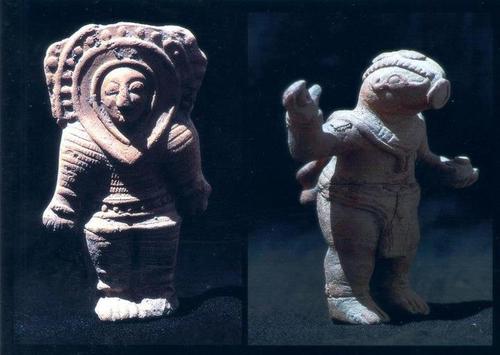
This look like the Mondoshawan if you combine both of them together ! probealy where where the producers got the Idea From >>> just Maybe
another from Ecuador
This intriquing ancient work of art from Ecuador, appears to be a man, or similar being, in a type of spacesuit. It is displayed beside a modern astronaut to demonstrate the remarkable similarities.
www.ancestryofman.com...
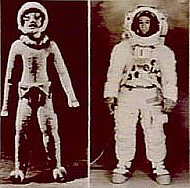
But this Here Look like transparent Helmets on their heads.. then again the So called Halos you see in Christian and Hindu Buddhist Art.. yet this art From Italy is over claimed to me
This cave painting, from ca. 10,000 BC, is from Val Camonica, Italy. It appears to depict two beings in protective suits holding strange implements.
www.ancestryofman.com...
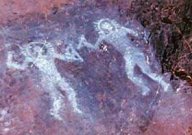
This intriquing ancient work of art from Ecuador, appears to be a man, or similar being, in a type of spacesuit. It is displayed beside a modern astronaut to demonstrate the remarkable similarities.
www.ancestryofman.com...
more convincing for an ancient astronaut for Proof ...
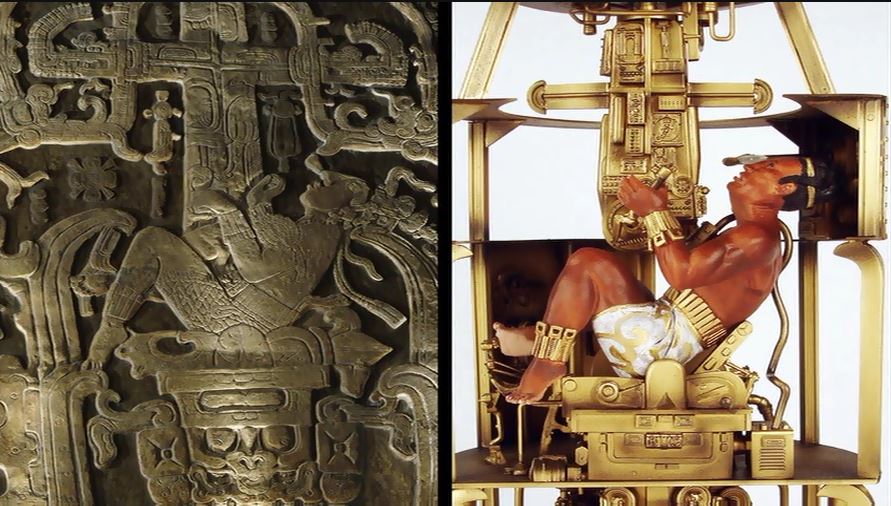
edit on 15-1-2014 by Wolfenz because: (no reason given)
edit on 15-1-2014 by Wolfenz because: (no reason given)
ElectricUniverse
BTW, another part of the Mahabharata which shows these weapons, and technology was given to the Hindu by the "celestials", and references to "celestial weapons" can be found in many chapters.
For example...
...
"Vaisampayana continued, 'Hearing these words of Arjuna, Angaraparna became inflamed with wrath and drawing his bow to a circle began to shoot his arrows like venomous snakes at the Pandavas. Then Dhananjaya, the son of Pandu, wielding a good shield and the torch he held in his hand, warded off all those arrows and addressing the Gandharva again said, 'O Gandharva, seek not to terrify those that are skilled in weapons, for weapons hurled at them vanish like froth. I think, O Gandharva, that ye are superior (in prowess) to men; therefore shall I fight with thee, using celestial weapons and not with any crooked means. This fiery weapon (that I shall hurl at thee), Vrihaspati the revered preceptor of Indra, gave unto Bharadwaja, from whom it was obtained by Agnivesya, and from Agnivesya by my preceptor, that foremost of Brahmanas, Drona, who gave it away to me.'
...
www.sacred-texts.com...
The weapons, and technology were called CELESTIAL for a reason, and not because they were invented by the Greeks as you claim....
My claim is that the Mahabharata credits the Greeks with inventing the vimana.
What you posted is a claim made by the narrator of the Mahabharata that a single, particular weapon was obtained from a Hindu god and passed through various hands, both human and divine, until said narrator had it.
Where is this weapon today? I give you credit for at least trying to find some written reference that the gods "gave technology" to humans, however.
But , as I said, they did not. For if they had, where is it today? Why didn't they use it in the 10th century BC when all this was supposedly happening?
So now, allow me to repeat what I said. You have no evidence at all that any Vedic myth describes the gods "giving vimanas and technology" to humans.
ElectricUniverseOh and btw, Vrihaspati should be written "Brihaspati" who was the "revered preceptor of Indra" both Brihaspati and Indra are Hindu gods who as you can see were some of the gods who gave this technology to the Hindus, despite your lies, I mean claims...
Yes, I know who he was.
Speaking of lies, your lie about Sacred Texts "editing out the word vimana" was a real doozy. The translations there are credited to the translators - almost all hindus, btw. They have not been changed.
It is convenient, once again, for you to pretend I said something I didn't so that you could accuse me of lying while simultaneously maintaining your false and sparkly worldview. But, unless ATS has "edited out the word vimana" from all my posts, it's easy enough for anyone to go see for themselves.
I still await your citation of a single Vedic text (with quote and link) that supports your claim that Hindus recieved technology and vimanas from the gods.
If you ever come up with that, I'll then ask you to provide textual evidence that these gods were from somewhere other than heaven - and I don't mean "the heavens."
Harte
Wolfenz
more convincing for an ancient astronaut for Proof ...
On the first page of your link we find the Lolladoff Plate - an admitted hoax.
The pic above is not an astronaut. It is the cover of Pakal's sarcophagus in Palenque, Mexico. It depicts Pakal falling (or climbing) through the Mayan Tree of Life, a motif found at many other Mayan sites. That's not an interpretation. The glyphs on the walls there - firmly translated only in the 1990's - tell us that.
Harte
edit on 15-1-2014 by Wolfenz because: (no reason given)
edit on 15-1-2014 by Wolfenz because: (no reason given)
reply to post by Harte
Really?... no evidence?... The reference I gave CLEARLY states the Gods gave celestial WEAPONS (as in PLURAL) to the Hindus.
Then Dhananjaya mentions ONE celestial weapon in particular he uses against his opponents the Gandharva. BTW, in case you didn't know the Gandharva were/are heavenly beings.
www.sacred-texts.com...
BTW, how about you show evidence from the Vedas claiming the Greeks invented the Vimanas...
I remember a reference from the Vedas in which it is said that for the first time humans saw the flying Vimanas from the Gods for the first time.
Really?... no evidence?... The reference I gave CLEARLY states the Gods gave celestial WEAPONS (as in PLURAL) to the Hindus.
Then Dhananjaya mentions ONE celestial weapon in particular he uses against his opponents the Gandharva. BTW, in case you didn't know the Gandharva were/are heavenly beings.
...
"Vaisampayana continued, 'Hearing these words of Arjuna, Angaraparna became inflamed with wrath and drawing his bow to a circle began to shoot his arrows like venomous snakes at the Pandavas. Then Dhananjaya, the son of Pandu, wielding a good shield and the torch he held in his hand, warded off all those arrows and addressing the Gandharva again said, 'O Gandharva, seek not to terrify those that are skilled in weapons, for weapons hurled at them vanish like froth. I think, O Gandharva, that ye are superior (in prowess) to men; therefore shall I fight with thee, using celestial weapons and not with any crooked means. This fiery weapon (that I shall hurl at thee), Vrihaspati the revered preceptor of Indra, gave unto Bharadwaja, from whom it was obtained by Agnivesya, and from Agnivesya by my preceptor, that foremost of Brahmanas, Drona, who gave it away to me.'
...
www.sacred-texts.com...
BTW, how about you show evidence from the Vedas claiming the Greeks invented the Vimanas...
I remember a reference from the Vedas in which it is said that for the first time humans saw the flying Vimanas from the Gods for the first time.
edit on 15-1-2014 by ElectricUniverse because: (no reason given)
Harte
...
What you posted is a claim made by the narrator of the Mahabharata that a single, particular weapon was obtained from a Hindu god and passed through various hands, both human and divine, until said narrator had it.
...
So now, allow me to repeat what I said. You have no evidence at all that any Vedic myth describes the gods "giving vimanas and technology" to humans.
LOL
Nice try, again you even asked for any reference when the gods gave technology and Vimanas to humans, I gave evidence of the gods giving celestial WEAPONS to Hindu and then proved that at sacred-texts the word Vimana is completely missing from all documents so from that source I can't show you mention of the gods giving vimanas simply because for some reason that word was completely taken out from that website...
You can even try using the search engine of sacred-texts and search for Vimana and you will not find ONE reference despite the fact that in other HINDU/INDIAN sources the word Vimana is used when describing most of the flying ships...
edit on 15-1-2014 by ElectricUniverse because: (no reason given)
Some REAL sources that describe what is described in the Vedas.
Here is the interesting part that responds your question as to what happened to this technology.
www.hinduwisdom.info...
The Vedas describes ancient wars in which atomic weapons were used and entire civilizations were destroyed this way.
However to this day there are sightings of "vimanas/ufos" some of which could be some of the gods survivors of the wars
The fact that to this day ufos are seen by military personnel, including fighter pilots, commercial pilots, and even regular people gives credence to the story of the Vedas of these ancient flying machines.
References from Ancient Literature
According to Professor Dileep Kumar Kanjilal in his book, Vimana in Ancient India:
In addition to the Vaimanika Shashtra, the Samarangana Sutradhara and the Yuktikalpataru of Bhoja, there are about 150 verses of the Rig Veda, Yajurveda and the Atharvaveda, a lot of literary passages belonging to the Ramayana, the Mahabharata, the Puranas, the Bhagavata and the Raghuvamsa and some references of the darma Abhijnanasakuntalam of Kalidasa, the Abimaraka of Bhasa, the Jatalas. the Avadhana Literature and of the Kathasaritsagara and a number of literary works contained either references to graphic aerial flight or to the mechanism of the aerial vehicles used in old ages in India.
In the Ramayana both the words "Vimana" and "Ratha" have been used:
•Kamagam ratham asthaya...nadanadipatim (3. 35. 6-7). He boarded the aerial vehicle with Khara which was decorated with jewels and the faces of demons and it moved with noise resembling the sonorous clouds.
•You may go to your desired place after enticing Sita and I shall bring her to Lanka by air.. So Ravana and Maricha boarded the aerial vehicle resembling a palace (Vimana) from that hermitage.
•Then the demoness brought the Puspaka aerial vehicle and placed Sita on it by bringing her from the Ashoka forest and she was made to see the battle field with Trijata.
•This aerial vehicle marked with Swan soared into the sky with loud noise.
Reference to Flying vehicles as Vimana occur in the Mahabharata in about 41 places of which the air attack of Salva on Krisna's capital Dwaraka deserve special notice. The Asura king Salva had an aerial flying machine known as Saubha-pura in which he came to attack Dwaraka. He began to shower hails, and missiles from the sky. As Krishna chased him he went near the sea and landed in the high seas. Then he came back again with his flying machine and gave a tough fight to Krishna staying about one Krosa (about 4,000 ft) above the ground level. Krishna at last threw a powerful ground-to-air weapon which hit the plane in the middle and broke it into pieces. The damaged flying machine fell into the seas. This vivid description of the air attack occurs in the Bhagavata also. We also come across the following references to missiles, armaments, sophisticated war-machines and mechanical contrivances as well as to Vimanas in Mahabharata.
For more on Ramayana, refer to chapters Glimpses XIX, Hindu Scriptures, Dwaraka, War in Ancient India, Survarnabhumi and Sacred Angkor.
...
Here is the interesting part that responds your question as to what happened to this technology.
Dileep Kumar Kanjilal concludes that: "With the passage of time and due to various changes of catastrophes the machines went out of use so that the secrets of its make-up and flying were equally lost. That the discontinuity of technical knowledge of a particular science within the known period of history is not an impossible factor has been shown by the inability to explore the nature of the rustless iron of the pillar of Chandraketu now fixed in Delhi. Hiuentzang, the Chinese pilgrim in the 7th century A.D. referred to 7 story palaces of which no evidence now remains. Sir P. C. Roy had shown that during the period from 1509 B.C. up to the end of the 3rd century B.C.E. methods for the large scale production of metals like gold, silver, copper, iron, tin, lead and mercury and of alloys like brass, bronze, and those of gold and silver with baser materials were known. Large varieties of mineral ores, gems, and precious stones have been described in detail by Kautilya. Knowledge of the fermentation process also reached a fairly advanced state. With a highly developed state of civilization flourishing in art, culture, literature, history, medicine, alchemy, chemistry, physics, mathematics, astronomy, and astrology, geology, trade, commerce, shipbuilding, and agriculture it is natural to think that some sort of flying vehicles as attested by literary references was in all probability known. From the time of Panini upto the time of Bhoja we come across references to the great universities of Taxila, Valabhi, Dhar, Ujjain and Visala etc. The annals of history inform us that the depredations of the foreign tribes began as early as the 2nd century A.D. From two centuries later came succeeding waves of attacks of other foreign hordes like the Arabs, Turks and Afghans. All the well known universities and other centers of learning like the temples, the Viharas and the Bhandaras containing books and other priceless treasures of the Indian heritage had to stand the fire and fury of the marauders. In the dark firmament of devastation and uncertainty a silver lining was, however, seen in the efforts of King Bhoja in the 12th century, when he tried to compile the Sanskrit texts. Glimpses of old heritage survived only in the memory of the people and in stray literary evidences. State patronization for Indian Hindu cultural enterprises in the Turk-Afghan/Islamic period was a misnomer."
The original designation of the flying machine was "Ratha" which gave way for the term "Vimana". The Samarangana Sutradhara unequivocally suggested that the design of the plane was imitated to construct palaces. It was built by the Rbhus for the Gods. Gods as pointed out by Sayana came from remote space in the sky above and the obvious conclusion is that Gods as newcomers on the earth from outer space brought in this technology. The texts of the Rig Veda ranging from the 1st-10th Manadal refers to aerial flying machines as Ratha. In the Yajurveda which is considered chronologically later than the Rg Veda followed by other Brahmanas, the name[/size=4]" Vimanas" occurs. These vehicles were multi-shaped. But the triangular or quadrangular pattern survived owing to their practical utility. Puspaka the aerial vehicel survived in use because of its practical usefulness. In the Vedic texts the configuration of the machines has been broadly shown as triangular. The inside area as it can be gathered from the text was about 9 ft X 9 ft. = 81 sq. ft capable of accommodating 7/8 persons. In a triangular delta wing type this can be easily be made conical to give it greater feasibility and maneuverability.
...
www.hinduwisdom.info...
The Vedas describes ancient wars in which atomic weapons were used and entire civilizations were destroyed this way.
However to this day there are sightings of "vimanas/ufos" some of which could be some of the gods survivors of the wars
The fact that to this day ufos are seen by military personnel, including fighter pilots, commercial pilots, and even regular people gives credence to the story of the Vedas of these ancient flying machines.
edit on 15-1-2014 by ElectricUniverse because: (no reason given)
ElectricUniverse
Harte
...
What you posted is a claim made by the narrator of the Mahabharata that a single, particular weapon was obtained from a Hindu god and passed through various hands, both human and divine, until said narrator had it.
...
So now, allow me to repeat what I said. You have no evidence at all that any Vedic myth describes the gods "giving vimanas and technology" to humans.
LOL
Nice try, again you even asked for any reference when the gods gave technology and Vimanas to humans, I gave evidence of the gods giving celestial WEAPONS to Hindu and then proved that at sacred-texts the word Vimana is completely missing from all documents so from that source I can't show you mention of the gods giving vimanas simply because for some reason that word was completely taken out from that website...
You showed one weapon given to one person by one god. You claimed "The gods gave technology and vimanas to the Hindus."
Regarding the rest: You know, there's a search function at Sacred Texts. Why don't you use it?
Vimana is not an English word. The texts at Sacred texts are old enough to be in the public domain, of course, because they are free. Older translations typically do not contain the word vimana because it's an English translation and vimana is not an English word
The Mahabharata there, for example, is a copy of the very first time the text was translated into English.
I've seen "vimana" translated as "air car," "airplane" and "aerial car," depending on whose translation you read. The same goes for many other translations that can be found online. These are old translations.
I've been reading these texts at Sacred texts for about twenty years. There's no editing done by the site. The only thing they do (occasionally) is drop a text or move it to another section.
ElectricUniverse
You can even try using the search engine of sacred-texts and search for Vimana and you will not find ONE reference despite the fact that in other HINDU/INDIAN sources the word Vimana is used when describing most of the flying ships...
LOLOLOL
Oh, Really? Link that shows you have no idea what you're talking about
Harte
edit on 1/16/2014 by Harte because: (no reason given)
Harte
Wolfenz
more convincing for an ancient astronaut for Proof ...
On the first page of your link we find the Lolladoff Plate - an admitted hoax.
The pic above is not an astronaut. It is the cover of Pakal's sarcophagus in Palenque, Mexico. It depicts Pakal falling (or climbing) through the Mayan Tree of Life, a motif found at many other Mayan sites. That's not an interpretation. The glyphs on the walls there - firmly translated only in the 1990's - tell us that.
Harte
edit on 15-1-2014 by Wolfenz because: (no reason given)edit on 15-1-2014 by Wolfenz because: (no reason given)
on the Site thats what it says its a claimed to be hoax Speaking gently of the Lolladoff Plate
We Then...... about Pakal's sarcophagus Cover ...
So what does he have on his ASS something he is climbing up or descending down with !
and if that is a Tree of Life ... or a Otherworld Descent ! aka going into another Dimension ( Possibly Wormhole ) still could be a Machine of some sort .. The Art Work would make H. G. Giger be Proud of !! A tree that looks Mechanical in a sense Well Still i would love to know the Representation of all the Details of the sarcophagus Lid of K'inich Janaab' Pakal
Well Hopefully Harte we can Both agree the similarity of the Old and New World ! Egyptian and Mayan
Both have mummification, Tombs sarcophagus Temples Pyramids Kings Pharaohs Priests and Hieroglyphs for a Written language and Worship the Main God the SUN ! and Similar Deity s with some Humanoid with Animal Heads yet Oceans Apart.. and both are architect masters ... to even Hair Braids! ( The Ice Maiden n Egyptian Queen Nofretari ) AGREE??
Compare and Contrast Ancient Egyptian and Mayan civilisations, can archaeology help account for these differences?
UNIVERSITY DEGREE ANTHROPOLOGY
www.markedbyteachers.com... count-for-these-differences.html
edit on 17-1-2014 by Wolfenz because: (no reason given)
Wolfenz
and if that is a Tree of Life ... or a Otherworld Descent ! aka going into another Dimension ( Possibly Wormhole ) still could be a Machine of some sort .. The Art Work would make H. G. Giger be Proud of !! A tree that looks Mechanical in a sense Well Still i would love to know the Representation of all the Details of the sarcophagus Lid of K'inich Janaab' Pakal
Well Hopefully Harte we can Both agree the similarity of the Old and New World ! Egyptian and Mayan
Both have mummification, Tombs sarcophagus Temples Pyramids Kings Pharaohs Priests and Hieroglyphs for a Written language and Worship the Main God the SUN ! and Similar Deity s with some Humanoid with Animal Heads yet Oceans Apart.. and both are architect masters ... to even Hair Braids! ( The Ice Maiden n Egyptian Queen Nofretari ) AGREE??
Yes, and I'd agree to a similar characterization/comparison involving any number of other cultures.
People have been entombing their dead for a long time. The Mayans didn't have any mummification process per se, though, but other cultures did. Those processes range from salt-packing to smoking the dead like a ham.
Worshipping the sun is a no-brainer. Everyone did that. And braids? Really?
Who doesn't braid hair?
Harte
edit on 1/17/2014 by Harte because: (no reason given)
Harte
What you posted is a claim made by the narrator of the Mahabharata that a single, particular weapon was obtained from a Hindu god and passed through various hands, both human and divine, until said narrator had it.
...
Celestial WEAPONS connotes more than one technolpogy that the god/aliens gave to makind. And vimanas were weapons as well. Again you are failing miserably. The word Vimana comes from sanscrit. it was't invented by modern men. This is why HIndu sources refer to them as Vimanas.
edit
on 18-1-2014 by ElectricUniverse because: (no reason given)
Harte
Wolfenz
and if that is a Tree of Life ... or a Otherworld Descent ! aka going into another Dimension ( Possibly Wormhole ) still could be a Machine of some sort .. The Art Work would make H. G. Giger be Proud of !! A tree that looks Mechanical in a sense Well Still i would love to know the Representation of all the Details of the sarcophagus Lid of K'inich Janaab' Pakal
Well Hopefully Harte we can Both agree the similarity of the Old and New World ! Egyptian and Mayan
Both have mummification, Tombs sarcophagus Temples Pyramids Kings Pharaohs Priests and Hieroglyphs for a Written language and Worship the Main God the SUN ! and Similar Deity s with some Humanoid with Animal Heads yet Oceans Apart.. and both are architect masters ... to even Hair Braids! ( The Ice Maiden n Egyptian Queen Nofretari ) AGREE??
Yes, and I'd agree to a similar characterization/comparison involving any number of other cultures.
People have been entombing their dead for a long time. The Mayans didn't have any mummification process per se, though, but other cultures did. Those processes range from salt-packing to smoking the dead like a ham.
Worshipping the sun is a no-brainer. Everyone did that. And braids? Really?
Who doesn't braid hair?
Harteedit on 1/17/2014 by Harte because: (no reason given)
Really??
HL-A antigens in mummified pre-Columbian tissues.
www.ncbi.nlm.nih.gov...
encyclopedia2.thefreedictionary.com...
Outside Egypt, in such widely separated places as the Aleutian Islands, the Canary Islands, China, and the countries now composing what was the Inca civilization, bodies preserved by various artificial means have been found. The venerated mummies of the Inca kings were destroyed by the Spanish. The Chinchoros culture of the N Chilean coast practiced artificial mummification around 5000–3000 B.C., and around 4000 B.C., corpses were deliberately salted at La Paloma, in central Peru. Pre-Columbian burials on the arid coast of Peru and Chile, often wrapped in textiles, tended to become naturally mummified. In the late 1990s a cache of late prehistoric mummies of the Chachapoyas culture was found in a rock shelter in humid NE Peru.
Obviously didn't research on
Type this and go to images in google or yahoo what ev..
The Ice Maiden n Egyptian Queen Nofretari
The Braid in their hair are Practically Identical .... ( as how they were made )
Ice Madien Peru

Queen Nofretari Egypt
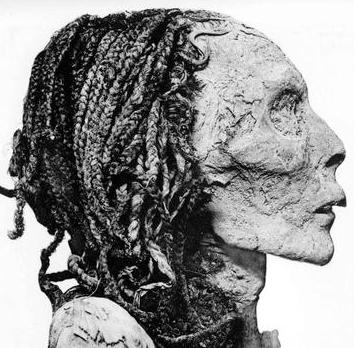
The Ancient Americas: migrations, contacts, and Atlantis
David Pratt
May 2009, Aug 2011
Part 1 of 2
www.davidpratt.info...
Here we go with Similarity's of Pre Columbia and Part of the Ancient OLD World
say a One World Civilization Trade Routes Ions ago??? a comparison....
Artefacts, Atlantis and the route to the sea
www.atlantisbolivia.org...
Pre-Columbian trans-oceanic contact
en.wikipedia.org...
edit on 18-1-2014 by Wolfenz because: (no reason given)
Wolfenz
Harte
Wolfenz
and if that is a Tree of Life ... or a Otherworld Descent ! aka going into another Dimension ( Possibly Wormhole ) still could be a Machine of some sort .. The Art Work would make H. G. Giger be Proud of !! A tree that looks Mechanical in a sense Well Still i would love to know the Representation of all the Details of the sarcophagus Lid of K'inich Janaab' Pakal
Well Hopefully Harte we can Both agree the similarity of the Old and New World ! Egyptian and Mayan
Both have mummification, Tombs sarcophagus Temples Pyramids Kings Pharaohs Priests and Hieroglyphs for a Written language and Worship the Main God the SUN ! and Similar Deity s with some Humanoid with Animal Heads yet Oceans Apart.. and both are architect masters ... to even Hair Braids! ( The Ice Maiden n Egyptian Queen Nofretari ) AGREE??
Yes, and I'd agree to a similar characterization/comparison involving any number of other cultures.
People have been entombing their dead for a long time. The Mayans didn't have any mummification process per se, though, but other cultures did. Those processes range from salt-packing to smoking the dead like a ham.
Worshipping the sun is a no-brainer. Everyone did that. And braids? Really?
Who doesn't braid hair?
Harteedit on 1/17/2014 by Harte because: (no reason given)
Really??
HL-A antigens in mummified pre-Columbian tissues.
www.ncbi.nlm.nih.gov...
encyclopedia2.thefreedictionary.com...
Outside Egypt, in such widely separated places as the Aleutian Islands, the Canary Islands, China, and the countries now composing what was the Inca civilization, bodies preserved by various artificial means have been found. The venerated mummies of the Inca kings were destroyed by the Spanish. The Chinchoros culture of the N Chilean coast practiced artificial mummification around 5000–3000 B.C., and around 4000 B.C., corpses were deliberately salted at La Paloma, in central Peru. Pre-Columbian burials on the arid coast of Peru and Chile, often wrapped in textiles, tended to become naturally mummified. In the late 1990s a cache of late prehistoric mummies of the Chachapoyas culture was found in a rock shelter in humid NE Peru.
Obviously didn't research on
Is English not your first language?
Your quote states precisely what I said.
Perhaps you are unaware that any dessicated corpse is usually referred to as a "mummy?"
I noted the salting. I noted the absence of any process, exactly what your quote referred to where it says "Pre-Columbian burials on the arid coast of Peru and Chile, often wrapped in textiles, tended to become naturally mummified."
I didn't click on your link but I note that your quote, at least, doesn't mention smoking the body. They did (maybe still do) that in New Guinea. Link
Oh well, as you say, "What ev..."
Harte
edit on 1/18/2014 by Harte because: (no reason given)
Harte
Wolfenz
Harte
Wolfenz
and if that is a Tree of Life ... or a Otherworld Descent ! aka going into another Dimension ( Possibly Wormhole ) still could be a Machine of some sort .. The Art Work would make H. G. Giger be Proud of !! A tree that looks Mechanical in a sense Well Still i would love to know the Representation of all the Details of the sarcophagus Lid of K'inich Janaab' Pakal
Well Hopefully Harte we can Both agree the similarity of the Old and New World ! Egyptian and Mayan
Both have mummification, Tombs sarcophagus Temples Pyramids Kings Pharaohs Priests and Hieroglyphs for a Written language and Worship the Main God the SUN ! and Similar Deity s with some Humanoid with Animal Heads yet Oceans Apart.. and both are architect masters ... to even Hair Braids! ( The Ice Maiden n Egyptian Queen Nofretari ) AGREE??
Yes, and I'd agree to a similar characterization/comparison involving any number of other cultures.
People have been entombing their dead for a long time. The Mayans didn't have any mummification process per se, though, but other cultures did. Those processes range from salt-packing to smoking the dead like a ham.
Worshipping the sun is a no-brainer. Everyone did that. And braids? Really?
Who doesn't braid hair?
Harteedit on 1/17/2014 by Harte because: (no reason given)
Really??
HL-A antigens in mummified pre-Columbian tissues.
www.ncbi.nlm.nih.gov...
encyclopedia2.thefreedictionary.com...
Outside Egypt, in such widely separated places as the Aleutian Islands, the Canary Islands, China, and the countries now composing what was the Inca civilization, bodies preserved by various artificial means have been found. The venerated mummies of the Inca kings were destroyed by the Spanish. The Chinchoros culture of the N Chilean coast practiced artificial mummification around 5000–3000 B.C., and around 4000 B.C., corpses were deliberately salted at La Paloma, in central Peru. Pre-Columbian burials on the arid coast of Peru and Chile, often wrapped in textiles, tended to become naturally mummified. In the late 1990s a cache of late prehistoric mummies of the Chachapoyas culture was found in a rock shelter in humid NE Peru.
Obviously didn't research on
Is English not your first language?
Your quote states precisely what I said.
Perhaps you are unaware that any dessicated corpse is usually referred to as a "mummy?"
I noted the salting. I noted the absence of any process, exactly what your quote referred to where it says "Pre-Columbian burials on the arid coast of Peru and Chile, often wrapped in textiles, tended to become naturally mummified."
I didn't click on your link but I note that your quote, at least, doesn't mention smoking the body. They did (maybe still do) that in New Guinea. Link
Oh well, as you say, "What ev..."
Harteedit on 1/18/2014 by Harte because: (no reason given)
Yes Harte Im Aware of The Term Mummy ... and I speak English Im just not a Grammar champion !!
Regardless the way the process was done still embalming was done let alone the Salt.. of the site link i have posted in case you don't know what the term embalming means ! ?? yet still most body's of royals on either side of the Ocean were in sarcophagus in Stone...
different methods and similar ways.. some Mummy's are Naturally preserved from the environment whether they were in Dessert Permafrost glaciers etc.. I talking about the intent of these mummies we are speaking of is done... Preserving them for the After Life... Well just one slight similarity between Pre Columbia and Egypt is Chinas Tarim Mummies that were in Pyramid Like Structures ! and Caucasian.. and their DNA is
Tarim mummies
en.wikipedia.org...
Well for Peru... and Ecuador and we know whats around that Environment right>?
interesting method.... in bold...
The Guanches, aborigines of Canary Island, and ancient Ethiopian tribes preserved their dead using methods much like those of the Egyptians, removing the viscera and filling the cavity with salt and vegetable powder. Low fire roasting of embalmed bodies was used by Jivaro tribes of Ecuador and Peru[ 1141926 ]. Recent study showed that Idoma and Igbo tribes of Nigeria also undertake low fire roasting of embalmed bodies[ 27 ].
ispub.com...
In Case you Missed !!
encyclopedia2.thefreedictionary.com...
Outside Egypt, in such widely separated places as the Aleutian Islands, the Canary Islands, China, and the countries now composing what was the Inca civilization, bodies preserved by various artificial means have been found. The venerated mummies of the Inca kings were destroyed by the Spanish. The Chinchoros culture of the N Chilean coast practiced artificial mummification around 5000–3000 B.C., and around 4000 B.C., corpses were deliberately salted at La Paloma, in central Peru. Pre-Columbian burials on the arid coast of Peru and Chile, often wrapped in textiles, tended to become naturally mummified. In the late 1990s a cache of late prehistoric mummies of the Chachapoyas culture was found in a rock shelter in humid NE Peru.
Artificial Means Preserved aka Not Natural !! ... Inca King Destroyed !! ?? and Artificial Mummification around 5000, to 3000 BC ??? some what like the Egyptian time of Mummification if you ask me So as it Seem that All around the Ancient World there was Mummification Preserving the Body for the After Life Egypt China and Pre Columbia aka New World..
and this IMO make me think of a Ancient sea goers ! going to distant lands for Trade... as Coco plants and tobacco was found on some of the Egyptain Mummies !
So Harte what do you think! ?? about this ?? Possible Transcontinental Trade Routes??
American Drugs in Egyptian Mummies
S. A. Wells
www.colostate.edu
www.faculty.ucr.edu...
The Mystery Of The Cocaine Mummy
Unless we go to the GOD/Alien/Civilization Type 3 Route going from Continent to continent...
Showing Primitive Man Secrets of Knowledge and Technology like Legends of Prometheus and Falling Angel Azazel
teaching mankind you have to admit I personalty doubt primitive Natives of lower north American central and south Americas
were able to have this technology on their Own... especially a place called Puma Punku...
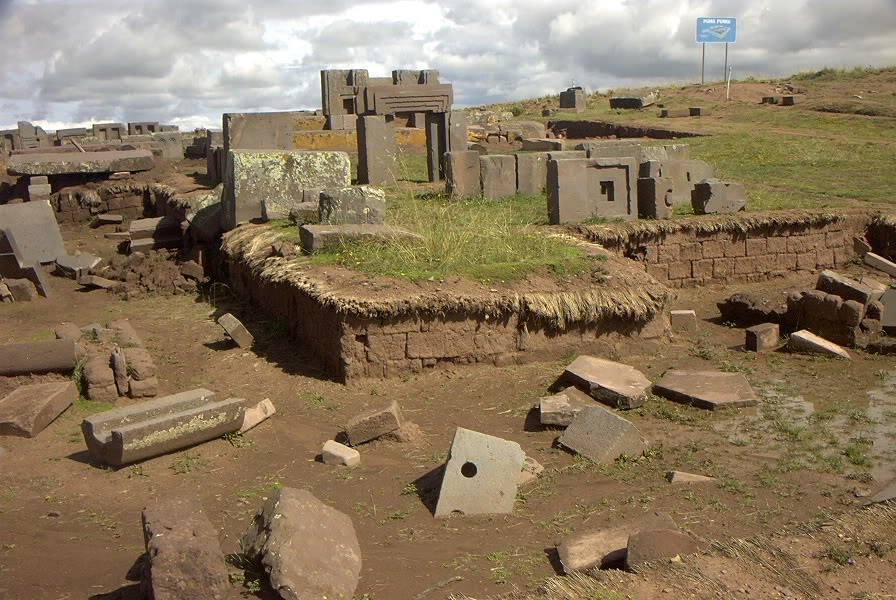
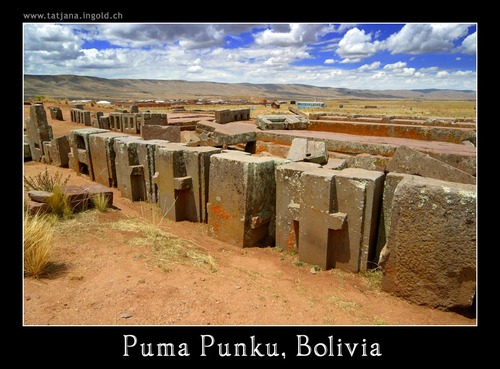
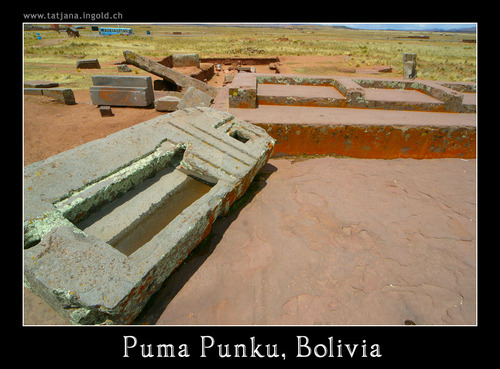
and a Pyramid called the pyramid of the sun !? speaking of which has high platforms around it for either trade marketing or landing pads.lol I dont buy the sacrificial BS what some have claimed what they were use for ...
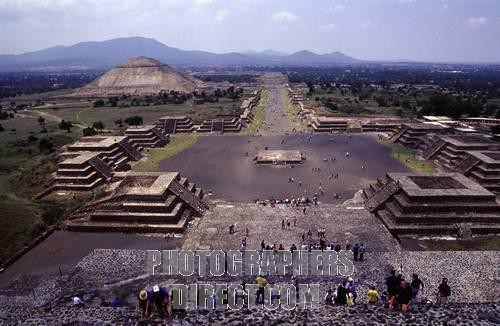
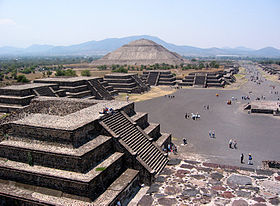
What the Pre Columbian Pyramids of the sun does remind me of is !
a Cross Between a Ziggurat of UR and a Egyptian Pyramid of Giza
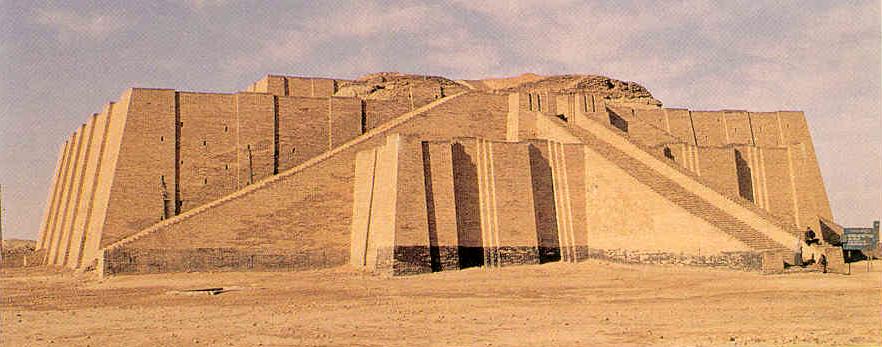
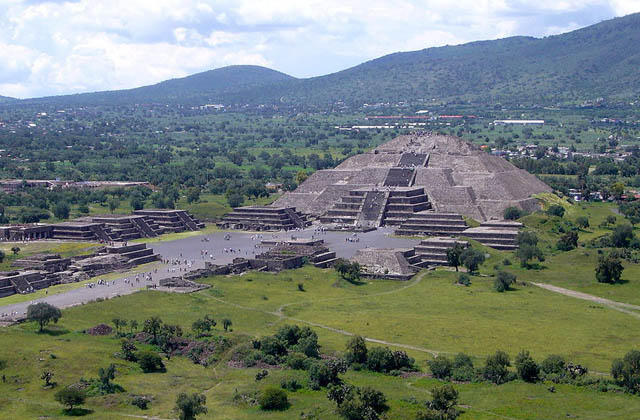
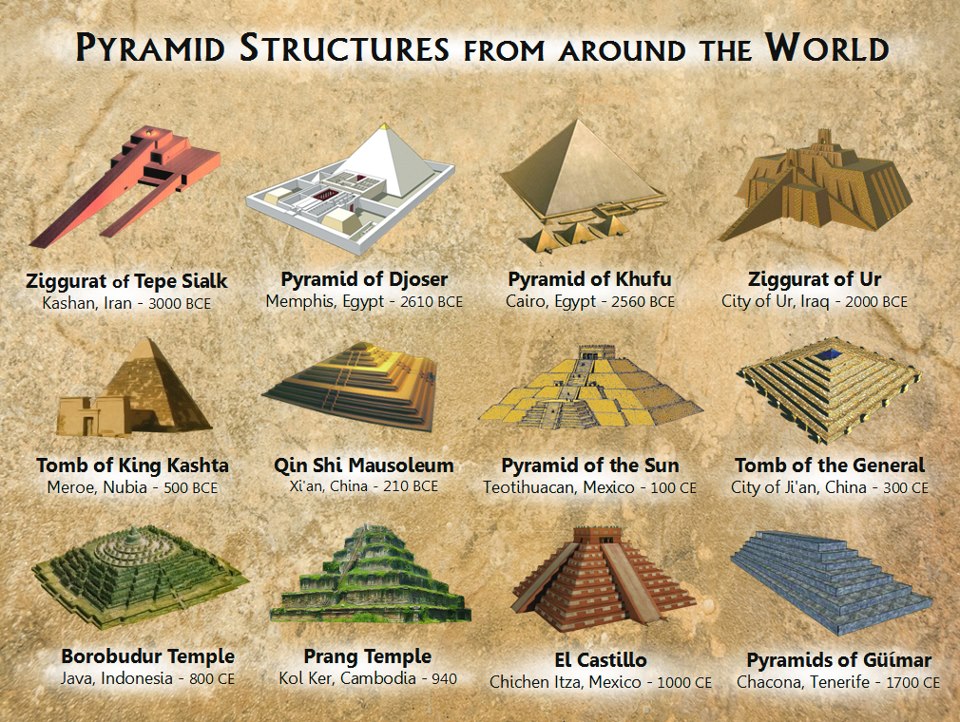
edit on 19-1-2014 by Wolfenz because: (no reason given)
reply to post by Wolfenz
Thanks for the info on the Chinchorro. It appears that for at least one period of their culture, they did utilize a mummification process that removed organs and brains. (the Red Mummy Technique)
When you look at it, it is only superficially similar to that of Egypt. The similarity ends with the removal of organs.
That people would preserve the dead is not in itself a revelation, however. Also, regarding your other statements, a pyramid is the only large edifice you can build when you don't have any advanced architectural techniques.
Also, the only Egyptian mummies to have been found contaminated with tobacco or coc aine are ones that have been on display for many years in Europe - including at "unwrapping parties" conducted by European upper-crust types a century ago.
More interesting to me is the THC containing mummies of the Americas.
Harte
Thanks for the info on the Chinchorro. It appears that for at least one period of their culture, they did utilize a mummification process that removed organs and brains. (the Red Mummy Technique)
When you look at it, it is only superficially similar to that of Egypt. The similarity ends with the removal of organs.
That people would preserve the dead is not in itself a revelation, however. Also, regarding your other statements, a pyramid is the only large edifice you can build when you don't have any advanced architectural techniques.
Also, the only Egyptian mummies to have been found contaminated with tobacco or coc aine are ones that have been on display for many years in Europe - including at "unwrapping parties" conducted by European upper-crust types a century ago.
More interesting to me is the THC containing mummies of the Americas.
Harte
Harte
You showed one weapon given to one person by one god. You claimed "The gods gave technology and vimanas to the Hindus."
Wow...you really must be daft or something.... The description CLEARLY states "Celestial WEAPONS" IN PLURAL not singular, then the main character of that passage states using one the WEAPONS, but you try to make it sound like it was just one weapon that he was given... He used one, but he described having been given several celestial weapons, not just one...
Harte
Regarding the rest: You know, there's a search function at Sacred Texts. Why don't you use it?
I did...
Harte
LOLOLOL
Oh, Really? Link that shows you have no idea what you're talking about
Harteedit on 1/16/2014 by Harte because: (no reason given)
First the only reference directly from the sacred-text website is a footnote, not on the text itself. The text in mention doesn't even say anything about a flying /aerial machine, just the footnote does.
Second, in every Indian/Hindu website even in the translations in English the flying machines are refered as Vimanas. But at sacred-text there is only one mention of a Vimana in a footnote and not on the text itself. Not to mention that the text to which the footnote is referring doesn't mention any flying machine...
As for the other texts, they can be seen to have been made in another format and maybe even someone else added them, but they do not seen to be part of sacred-text website, but instead additions that other people did in other formats, hence the letters in green and background black which is completely different to the format used normally for the sacred-text translations.
BTW, you first wanted to dismiss Childress, and now you are posting writings made by him?... Flip-flop much?
edit on 20-1-2014 by ElectricUniverse because: (no reason given)
Harte
....
That people would preserve the dead is not in itself a revelation, however. Also, regarding your other statements, a pyramid is the only large edifice you can build when you don't have any advanced architectural techniques.
....
Harte
Really? is that why pyramids made of the same type of stones, with the same/similar weights in modern times cannot be built using the old technologies claimed that the ancient Egyptians used?...
Did the Japanese attempt to rebuild the great pyramid?
In: Great Pyramid of Giza [Edit categories]
Answer:
In 1978 the Japanese corporation, Nippon attempted to build a 60 foot high pyramid using primitive building techniques (similar to the techniques assumed by mainstream Egyptologists, which I personally do not believe*). They were to build it from one blocks of limestone quarried from the same site used by The Great Pyramid builders quarried. Once built the Japanese were told by Egyptian authorities to dismantle it and return the site to its original state.
From the start they struggled with using old and archaic technology and techniques - even transporting the blocks across the River Nile proved too difficult so eventually they were ferried across by steamboat. Teams of 100 men attempted to move the stones over the ground but failed completely. Once again modern vehicles had to be used to move the stones but once at the site could not be lifted in to place. In the end they used a crane and helicopter to position the blocks.
wiki.answers.com...
Harte
reply to post by Wolfenz
Also, regarding your other statements, a pyramid is the only large edifice you can build when you don't have any advanced architectural techniques.
new topics
-
New UK Petition - Close the borders! Suspend ALL immigration for 5 years!
Regional Politics: 42 minutes ago -
The Looking Glass - Episode 3: The Path of Least Resistance
Short Stories: 2 hours ago -
Credit card debt
Relationships: 4 hours ago -
President-elect Trump asks the Supreme Court to Let Tik-Tok Continue Operating in the U.S..
Mainstream News: 5 hours ago -
Treasury Secretary Janet Yellen Says The USA Will Be in Debt Default in Jan 2025 - Unless...
Mainstream News: 9 hours ago -
Trash To Treasure: Dumpster Diving With Mike The Scavenger
General Chit Chat: 9 hours ago -
Danish Prime Minister said to keep 3 days worth of canned goods on hand
World War Three: 10 hours ago
top topics
-
The hunter has become the hunted
Politicians & People: 13 hours ago, 19 flags -
Trump's idea to make Canada the 51st US state: 'Potential is massive'
Mainstream News: 13 hours ago, 14 flags -
Danish Prime Minister said to keep 3 days worth of canned goods on hand
World War Three: 10 hours ago, 5 flags -
Treasury Secretary Janet Yellen Says The USA Will Be in Debt Default in Jan 2025 - Unless...
Mainstream News: 9 hours ago, 5 flags -
Trash To Treasure: Dumpster Diving With Mike The Scavenger
General Chit Chat: 9 hours ago, 3 flags -
Credit card debt
Relationships: 4 hours ago, 3 flags -
President-elect Trump asks the Supreme Court to Let Tik-Tok Continue Operating in the U.S..
Mainstream News: 5 hours ago, 1 flags -
The Looking Glass - Episode 3: The Path of Least Resistance
Short Stories: 2 hours ago, 1 flags -
New UK Petition - Close the borders! Suspend ALL immigration for 5 years!
Regional Politics: 42 minutes ago, 0 flags
active topics
-
Credit card debt
Relationships • 3 • : Flyingclaydisk -
Liberal Madness and the Constitution of the United States
US Political Madness • 16 • : charlest2 -
New UK Petition - Close the borders! Suspend ALL immigration for 5 years!
Regional Politics • 0 • : gortex -
Trump's idea to make Canada the 51st US state: 'Potential is massive'
Mainstream News • 44 • : Freeborn -
-@TH3WH17ERABB17- -Q- ---TIME TO SHOW THE WORLD--- -Part- --44--
Dissecting Disinformation • 3829 • : Crazierfox -
The Looking Glass - Episode 3: The Path of Least Resistance
Short Stories • 3 • : JJproductions -
Danish Prime Minister said to keep 3 days worth of canned goods on hand
World War Three • 5 • : DerBeobachter2 -
No Wonder We Are In Such INSANE Debt- Americans MUST Put a Stop to This
US Political Madness • 68 • : BernnieJGato -
President-elect Trump asks the Supreme Court to Let Tik-Tok Continue Operating in the U.S..
Mainstream News • 15 • : TheMisguidedAngel -
Elon Musk futurist?
Dreams & Predictions • 21 • : cherokeetroy

